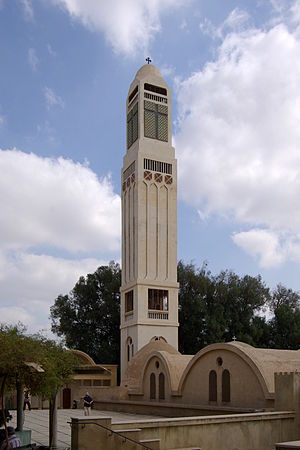- Monastery of Saint Macarius the Great
-
The Monastery of Saint Macarius is a Coptic Orthodox monastery located in Wadi El Natrun, Beheira Governorate, about 92 km north west of Cairo, and off the highway between Cairo and Alexandria.
Contents
Ancient History
The monastery was founded in approximately 360 A.D. by Saint Macarius of Egypt, who was the spiritual father to more than four thousand monks of different nationalities. From its foundation in the fourth century up to the present day, the monastery has been continuously inhabited by monks. Several Christian saints and fathers of the early Church were monks at the Monastery of Saint Macarius, such as Saint Macarius of Alexandria, Saint John the Dwarf, Saint Paphnutius the Ascetic, Saint Isidore, Saint Arsenius, Saint Moses the Black, Saint Poemen, Saint Serapion and many others..
Modern history
In 1969 the monastery entered an era of restoration, both spiritually and architecturally, with the arrival of twelve monks under the spiritual leadership of Father Matta El Meskeen. These monks had spent the previous ten years living together entirely isolated from the world, in the desert caves of Wadi El Rayyan, about 50 kilometres south of Fayoum.
It was the late Pope Cyril VI who ordered this group of monks to leave Wadi El Rayyan and go to the Monastery of Saint Macarius the Great to restore it. The Pope received them, blessed them, assured them of his prayers and asked God to grant their spiritual father grace that the desert might bloom again and become the home of thousands of hermits. At that time only six aged monks were living in the monastery and its historic buildings were on the verge of collapsing. The new monks were warmly received by the abbot of the monastery, Bishop Michael, Metropolitan of Assiut, who through his wisdom and humility was able to create an atmosphere favourable to the renewal they hoped for.
Today, under Pope Shenouda III, who is himself busily engaged in restoring the Monastery of Saint Pishoy and the Paromeos Monastery, and after fourteen years of constant activity both in reconstruction and spiritual renewal, the monastic community in the Monastery of Saint Macarius numbers about one hundred monks. The monks live in strong spiritual unity, according to the spirit of the Gospel, practising brotherly humility and the unceasing prayer of the heart. They are all directed by the same spiritual father who watches over the unity of the spirit of the monastery. The renewal is also revealed in the diligent prayer of the daily office and other liturgical services, for it is the aim of the monks to revive in the Church the spirit of the first centuries of Christianity, both by their rule of life and by conscientious study.
The Monastery of Saint Macarius maintains spiritual, academic and fraternal links with several monasteries abroad, including the monastery of Chevtogne in Belgium, Solesmes Abbey and the Monastery of the Transfiguration in France, Deir El Harf in Lebanon and the Convent of the Incarnation in England.
The Monastery of Saint Macarius the Great contains the relics of many saints, such as the Forty Nine Elder Martyrs of Scetes.
The discovery of the relics of Saint John the Baptist and Elisha the Prophet
During the restoration of the big Church of Saint Macarius, the crypt of Saint John the Baptist and that of Elisha the Prophet were discovered below the northern wall of the church, in accordance with the site mentioned in manuscripts from the 11th & 16th centuries found in the library of the monastery. This is also confirmed by the ecclesiastical tradition of the Coptic Orthodox Church. The relics were then gathered in a special reliquary and placed before the sanctuary of Saint John the Baptist in the church of Saint Macarius. A detailed account of this discovery and an assessment of the authenticity of the relics have been published by the monastery.
Current Abbot
The current abbot of the monastery is Fr. Kyrillos. He replaced Fr.Matta El Meskeen after his departure in June 2006.
Other Monasteries of the Nitrian Desert
See also
- Macarius of Egypt
- Coptic Orthodox Church
- Desert Fathers
- Wadi El Natrun
- Saint Bashnouna
- Father Matta El Meskeen
Links
References
Upper Egypt: 
Middle Egypt: Monastery of Saint ParsomaLower Egypt: Eastern Desert: Scetes: Monastery of Saint Macarius the Great · Monastery of Saint Pishoy · Paromeos Monastery · Syrian MonasterySinai: Category – Christianity in Egypt – Monasteries by country Categories:- Christian monasteries in Egypt
- Coptic Orthodox monasteries
- Christian monasteries established in the 4th century
Wikimedia Foundation. 2010.



